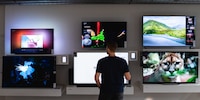
Guide
The ultimate TV guide: which should I buy?
by Luca Fontana

LG held the throne for a long time with its G3. But now it's time to change the guard: Sony's A95L is the best TV I've ever tested.
Before we get to the test: If you want to buy a new TV, you first have to fight your way through a jungle of features and technologies. Want to see the big picture? And a few recommendations? I'll help you through the jungle.
So, now to the test.
This is one of the product tests I look forward to the most every year: Sony's flagship TV. Not because the TV manufacturer from Japan scores with its own new panel technologies. It usually buys these from its competitors LG or Samsung. But because it supplements them with its own processors and often improves them as a result.
"The image technology is one thing," Sony people have often told me, "but how the individual pixels are controlled and the image is processed by the processor is something completely different."
In the case of the A95L, it is the successor to last year's A95K, a QD OLED TV. Incidentally, this was the first of its kind, even though QD-OLED is a technology developed by Samsung. The "QD" in QD-OLED stands for Samsung's Quantum Dots: special colour filters that not only ensure more beautiful colours, but also indirectly increase the maximum brightness of the TV. This is crucial for the match, especially for otherwise rather modest OLED ratios when it comes to maximum brightness.
Let's see, literally, what Sony's new flagship can do.
In terms of design, Sony scores with the flexibility of the stand design. The panel, which stands firmly on its two black, metal duck feet, can be adjusted in height. This creates a gap of around eight centimetres between the panel and the furniture. This is important so that any soundbar does not cover the TV's infrared sensor for the remote control. What's more, the two feet are not positioned in the centre, as is the case with most competitors' stands, but on the left and right edges of the panel. This creates enough space in between for the soundbar in question.
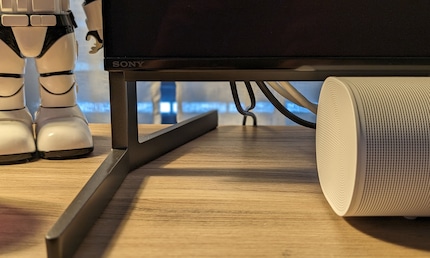
The second option, on the other hand, is perfect if you don't have a soundbar. Simply slide the panel down along the feet until the gap between the panel and the furniture closes. The feet are then barely visible looking forwards and backwards away from the screen. It almost looks as if the panel is sitting directly on the furniture.
Very clever. And nice. If I didn't have a soundbar, this would definitely be my choice. Like here in the digitec shop in Dietikon.
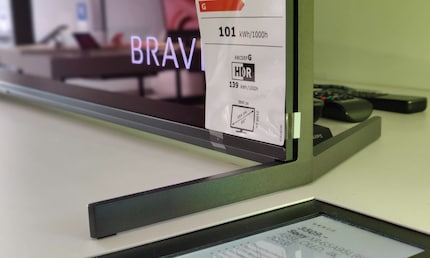
Other than that, Sony remains true to what most other manufacturers imagine a television to be. Modern. Slim. Narrow edges. Nothing out of the ordinary - and that's a good thing. Televisions are supposed to be televisions, I think.
Viewed from the side, Sony's A95L is around 3 centimetres thin. The panel is held together by an elegant aluminium frame at the front and a black plastic cover plate at the back. The A95L can therefore be easily mounted on a wall - but you will need a VESA 300×300mm mount, which is not included. You can find this here in our shop.
About the soundbar: If it were up to Sony, you wouldn't necessarily need a soundbar for the sound. For years, the Japanese company has relied on its in-house sound technology "Acoustic Surface Audio+": four drivers installed behind the TV do not vibrate air like conventional speakers, but the panel itself:
Strictly speaking, a 2.2 system. But Sony doesn't want to be specific. Thanks to "3D Surround Upscaling" - a nicer term for digital sound manipulation - more speakers are simulated than are physically present. That's why the system also supports Dolby Atmos.
What can I say? I'm still amazed at how well this system works: No other TV creates such a voluminous and equally powerful sound image with its conventional internal speakers. I would even go so far as to say that "Acoustic Surface Audio+" easily replaces a mid-priced soundbar. But if you want surround sound - real surround sound - you can't get around a home cinema system.
Sony knows this. That's why there's this feature, which is not new but is still up to date: the TV can be used as a centre speaker within a hi-fi system. This means you don't need a dedicated centre speaker or soundbar. Or you can go straight for the HT-A9 sound system. Four speakers create a 360-degree sound stage - no matter where you place them.
On the other hand, if you connect the TV to a Sony soundbar, the A95L does not become the centre speaker, but it does focus its sound on high frequencies and voices. This in turn reduces the load on the Sony soundbar, whose free computing capacity improves the sound over the mid and low frequencies. Incidentally, Sony has paid close attention to the design of the feet so that every Sony soundbar fits perfectly in between.
About the connections. They are behind the TV and on the side:
All four HDMI inputs support HLG, HDR10 and Dolby Vision. Only HDR10+ is missing. What a pity. But its distribution is very limited anyway: to date, I have only seen a few HDR10+ contents on Prime Video. The pass-through function for Dolby Atmos and DTS 5.1 audio signals is a very positive feature. You will need this if you use an external device as a player. A UHD Blu-ray player, for example. Unfortunately, I was unable to test whether the pass-through function also works with DTS:X because my soundbar - a Sonos Arc - only supports a maximum of DTS 5.1 surround.
What comes next goes deep into the subject matter. If you're not interested in tables and diagrams, you can skip all that and scroll straight to the chapter "The picture: powerful yet natural". From there, you'll find my subjective impressions with lots of video material.
I measured all of the TV's screen modes using professional tools from "Portrait Displays". From "Standard" to "Film" to "Dolby Vision", without calibration and manual changes in the settings. Just like most normal mortals use a television. After all, you want to know whether a TV is accurate and true to colour even without expensive and professional calibration.
The best values for all types of content were achieved in "Dolby Vision" mode. The measurements listed below therefore always refer to this mode. Except for gaming, for which you should always use the "Play" mode.
Let's start with the brightness measurement. As I said, unlike its OLED competitor LG, Sony relies on Samsung's Quantum Dots for the A95L. In simple terms, they ensure that the millions of pixels in the display produce colours without having to accept any loss of brightness. I have explained the physics behind this here.
Another advantage of quantum dots is that they produce a picture that is at least as bright with even more intense colours than LG's OLED technology with less energy input. This should reduce the risk of burn-in. In theory, at least.
However, QD OLED technology is still so new that real long-term tests under realistic conditions are in short supply. However, initial laboratory tests carried out by the tech portal Rtings have come to a rather worrying conclusion for Samsung and its partners: QD OLED appears to be more susceptible to burn-in than LG's current OLED generation. Specifically, this year's MLA panel, which LG is using in the G3 series.
So let's see what the practice says in the brightness test. In the chart, I compare it directly with LG's flagship, the G3, Samsung's S95C, which also uses a QD OLED panel from its own factories, and Sony's A95K, the predecessor of the A95L.
There are two axes: the vertical axis stands for brightness, the horizontal axis for the section in which the brightness is measured. At two per cent of the entire screen, i.e. selectively and with very small image areas, Sony's A95L achieves an excellent overall value of 1458 nit in Dolby Vision mode by OLED standards. If I measure in the TV's Brilliant mode - the brightest but worst calibrated mode - the measuring device even achieves an incredible 2089 Nit!
A year ago, values like that would have blown my mind. Not anymore, because LG's G3 has built a similarly bright TV despite its "outdated" technology - at least in certain spots and in small image areas. For example, the sun in the evening sky.
What do these measurements tell us? Well, when it comes to the maximum difference between the brightest and darkest pixels - the contrast - Sony and LG are ahead of Samsung. However, when measuring the entire picture area - the overall brightness - Sony, Samsung and LG perform almost equally and achieve a very solid 250 nit. If you were to place all the TVs next to each other, you probably wouldn't notice any major differences in brightness.
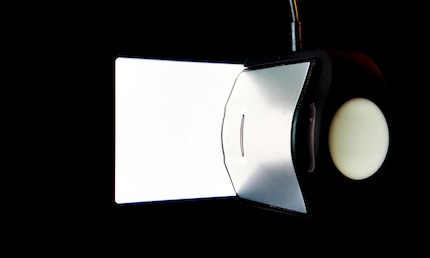
But why does LG's TV shine as brightly as Sony's A95L, when we've just established that QD OLED TVs should shine brighter? Well. LG has caught the whole industry off guard. The reason for this is a newly added layer in the LG panel - the Micro Lens Array (MLA). Here, convex microlenses ensure that the light produced is focussed and amplified. LG even talks about 5000 lenses per pixel. And: Apparently this doesn't even seem to happen at the expense of more burn-in, if we believe Rting's lab tests - which I usually do. A strong year for LG.
Let's take a look at the white balance of the TV. White is created on the TV when the red, green and blue subpixels per pixel radiate simultaneously and with equal intensity. Full brightness therefore produces the brightest white. The lowest brightness, on the other hand, produces the deepest black. If the subpixels can even be switched off completely, as with OLED or QD-OLED, this is referred to as true black. Everything in between is therefore nothing more than shades of grey.
To measure the accuracy of the white balance, I need two tables:
The greyscale dE shows how much the greyscale generated by the TV deviates from the reference value. The RGB balance shows in which direction the grey levels generated by the TV deviate from the reference value. Why is this important? Let's take a look at the specific A95L example:
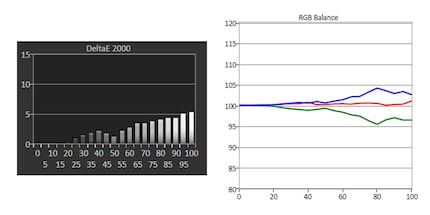
If you were to place the TV directly next to a reference monitor, this would mean:
Any value below five is a very good value for a non-calibrated television. And Sony's A95L almost achieves what only Samsung's S95C did among the televisions I tested: keeping the incorrect deviation below the aforementioned value of five throughout - i.e. at every brightness level. On average, Sony's QD OLED TV achieved a very good dE value of 2.55. LG's G3 also achieved a good 3.19. Samsung's S95C undercut Sony's value with a dE of 1.77.
A look at the RGB balance (top right in the image) now shows to what extent the white balance deviates from the reference value. The whiter the white produced, the more of a slight blue cast is visible. At the same time, the green component in the white decreases slightly. In other words, the blue sub-pixels are slightly too bright and the green sub-pixels are slightly too weak. But as I said, the deviation is just below dE 5. It is therefore very unlikely that you will actually see the slight deviation in the real image or even find it disturbing.
We continue with the measurement of the colour gamut, the coverage of the most common colour spaces. These are:
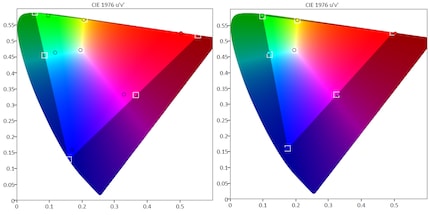
The large "colour blob", including the darkened areas, shows the full range of colours that can be seen by the human eye. The brightened area on the left shows the BT.2020 colour space, and the same on the right, simply the smaller DCI-P3 colour space. The white boxes show the actual limits of the respective colour spaces. The black circles, on the other hand, show the limits actually measured during measurement.
The measurement resulted in the following colour space coverages:
The A95L achieves excellent 99.78 per cent coverage in the important DCI-P3 colour space. However, all OLED televisions do well in this category: LG's G3 achieved 98.67 per cent.
Sony's A95L also covers the BT.2020 colour space very well at 91.54 per cent - and that is not a matter of course. Even LG's G3 with its MLA panel "only" achieves 74.12 per cent. This speaks in favour of the future viability of QD OLED technology.
The colour error, i.e. the colour fidelity. Unlike the gamut above, it does not describe whether, but how accurately colours are displayed in a specific colour space.
The deviation from the TV to the reference value is also referred to here as dE. The white boxes show the reference colours sent to the TV by the test pattern generator. The black circles, on the other hand, show the colours actually measured. Ideally, the circles should be exactly in the box. That would be "accurate". The further outside the circles are, the greater the deviation from the reference value - and therefore the dE value. Once again: dE values below 5 are good for non-calibrated televisions.
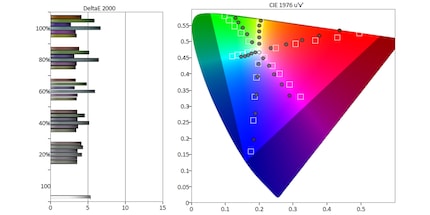
The measurements are good - and no surprise. Not after I measured the already very well calibrated white balance. Because the more accurate the white balance, the more accurate the resulting colours. In figures: Sony's A95L has an average dE of a good 4.16 in "Dolby Vision" mode, but I'm not over the moon: LG's G3 achieved an even lower dE value of 1.97 - Samsung's S95C undercut both: 1.33 in "Filmmaker mode".
However, all three TVs - Sony and LG in "Dolby Vision" mode, Samsung in "Filmmaker mode" - perform at a high level. Without a trained eye, the differences are almost indistinguishable.
It is not possible to measure reflections on the screen per se. However, some of you have written to me and asked me to include them in my tests anyway. Good idea. To test this, I'll recreate a completely normal situation in the living room: first a photo in the evening. Behind me is the oven, next to the TV is the floor lamp. The light from the floor lamp is reflected by the window of the oven behind me and thrown back onto the TV.
And here is the result:
Sony's A95L doesn't do badly in comparison with LG's G3. Both cope well with the reflection hitting the dark image directly, even if LG's panel looks a little more anti-reflective.
The reflections are much more difficult to deal with during the day without closed curtains, blinds or shutters. Then, when there is also light on the panel from the side. Nevertheless, I have to say that Sony's QD OLED panel does a much better job than the mini LED panel on the Sony X95L:
Sony's new QD OLED generation makes me happy. It has not only improved greatly in terms of overall brightness, but also impresses with an incredibly reference-worthy picture - straight out of the box, without calibration. At least if you use the Dolby Vision mode. In theory, Sony has created a TV that is more than a match for LG's G3. Let's now take a look at the practice.
The measurements above attest to the TV's good colour space coverage with very high colour fidelity. In theory. What does it look like in practice? I compared Sony's A95L with its two main competitors, LG's G3 and Samsung's S95C. Both South Korean TVs are in the same league as Sony's flagship in terms of both price and technology. But who will win the race?
When I want to test a TV for its colour reproduction, I turn to "Guardians of the Galaxy, Vol. 2". This scene in particular: it shows the finest details in the sky without overemphasising them, has that certain punch in the picture that I like so much about OLED displays - with or without "QD" on the front - and Ego's golden palace pops in the saturated evening red. Sony's A95L perfectly fulfils the director's intention of capturing the planet's kitschy "Golden Hour". I particularly like the warm, reddish skin tones, which are a little too yellowish on LG's strong OLED MLA panel and Samsung's QD OLED cousin.
To add some variety, I've included a scene from "Avatar: The Way of Water" for testing, where green and especially blue tones dominate. Especially with the bluish skin tone of the nature-loving Na'vi, it quickly becomes apparent that Sony's TV has slightly more saturation than its competitors. For example, the fresh, lush green colour when you look at the jungle in the background. I really like that. LG's G3 looks more natural in this scene - but frankly, I still personally like Sony's handling of the green and blue tones better.
I have a very similar feeling about "James Bond - Skyfall", when James and the young quartermaster Q look at the picture of a proud old battleship in an art museum, which is disgracefully being towed to the scrapyard. An allusion to the ageing secret agent, of course.
Sony's picture is also the most convincing here - even though LG's G3 definitely looks the most natural. At least if I only pay attention to the skin tones. However, Sony has a nice, pleasant and warm tone here, which appeals to me personally the most. With Samsung, on the other hand, a slight red cast creeps into the picture. I already criticised this with earlier Samsung TVs.
How does Sony perform in dark scenes? The first scene from "Blade Runner 2049" is used for this test. Sony, LG and Samsung's (QD) OLED televisions are wonderfully dark. If you film against the light, it is normal for details to disappear in black silhouettes - known as black crush. LG has the most of this. Could be intentional. The fact that Sony and Samsung have less black crush could also be due to the QD OLED panel.
At the end of the video above I have added TCL's C93 for comparison, not an OLED TV, but an LCD TV with a mini-LED backlight. Due to the technology, this shines brighter than any OLED panel. In dark scenes, it's even far too bright for my taste. There is also blooming, a kind of halo around bright objects. Good to see with the windows. You never see that with OLED televisions. Or all the details in dark areas of the picture; TCL's mini LED TV brightens up areas that I don't think should be brightened up. That looks wrong.
Also: The director deliberately filmed against the light because he wanted the dark areas of the picture to be really dark.
A final image test: Detail reproduction in bright image areas. Pay attention to the sun in the background in the following "Jurassic World" example: Even in such a bright image area, the gradations of Sony's A95L are still so fine that the sun can easily be recognised as a sphere in the firmament. This is much less the case with LG and Samsung.
The processor is the brain of the TV. Its main task is to receive, process and display image signals. Processing means that the processor recognises poor picture quality and enhances it. It does this, for example, by removing noise, enhancing colours, smoothing edges, making movements smoother and adding any missing pixel information.
At the start, I make it really difficult for the processor. Specifically: Judder, a phenomenon that all TVs have. Especially with long camera pans. Sam Mendes' "1917" is full of such smooth, slowly flowing camera movements and is therefore perfect for the judder test. When comparing with other manufacturers, pay particular attention to whether the vertical bars in the barn run smoothly through the picture or stutter.
It seems that Sony has finally listened to me: the Japanese manufacturer is reluctant to intervene in judgement reduction. Sony believes that a film must be smooth. Just like in the cinema in the old days, before the digital age. Nice and old-fashioned. It was always too much of a stutter for me. Even without readjustment in the menu under "Clarity", the picture doesn't flow too badly, especially compared to Samsung. LG, on the other hand, is still the clear top dog, at least in this respect.
Next scene from "1917". Here, too, Mendes' camera work poses an immense challenge for most processors. Especially with hard edges against a blurred background, for example around the helmets of the two soldiers. Here, both the processor and the pixels have to react incredibly quickly.
Sony's processor performs very well, even if it doesn't flex its muscles quite as much as LG, for example. But that's complaining at a high level: the picture flows, but never looks unnatural. Even with Samsung in the second comparison, I think.
Next, the Apple original "For All Mankind". I want to see how long it takes a single pixel to change colour. If this doesn't happen fast enough, it looks to you as if the image is streaking - the effect is called "ghosting". When panning the camera across the surface of the moon, pay attention to the text displayed at the bottom left.
Problems? Not at all. At least not with Sony, LG and Samsung, where the superimposed text always remains sharp. But to give you an idea of what the smearing I'm talking about looks like, I've included a comparison with TCL's C82 model at the end. To be fair, it has to be said that this is a TV that is two years older. The example is therefore for illustrative purposes only. TCL's C92, its successor, improved significantly in the same discipline last year.
In summary, the example speaks in favour of Sony's outstanding processor. On the other hand, the video also shows the excellent pixel response times that are so typical of OLED televisions. This is why they are also considered exquisite gaming monitors. LCD televisions are usually at a disadvantage in this respect.
Now the most difficult test. Here I want to see how well the processor upscales less high-quality sources. Blu-rays or good old live television, for example. Or "The Walking Dead". The series was deliberately shot on 16mm film to create the feeling of a broken, post-apocalyptic world with old-fashioned grain and image noise.
Sony's processor also cuts its usual fine figure here. As usual, because Sony's processors have been particularly good at upgrading inferior sources in recent years. In other words, the picture is sharply defined, pleasantly warm, rich and yet natural. In addition, there is almost no picture noise or compression artefacts. However, LG does the best job in the three-way comparison. The best way to see this is to pause the video below and pay close attention to the dark area between the two hostile men.
When measuring the colour correctness in "Game Mode", I achieved an average Delta E of a good 5.21 (see "Colour Error" above if you are interested in the details of this topic). This is not a reference image level. But it's one of the better values I've measured on a TV in "Game Mode".
On input lag: With the measuring device from "Leo Bodnar", I measured an average input lag of 16.3 milliseconds with a UHD picture at 60 frames per second. Not exactly overwhelming. But within the 20 milliseconds allowed for televisions, which a game mode should be able to achieve in 2023. The TV also supports all features relevant for gamers:
To this end, Sony - just like Samsung, LG, Philips, TCL and Panasonic - has entered into a partnership with major gaming studios. The result: HGiG - HDR Gaming Interest Group. According to the manufacturer, this should ensure that HDR is displayed as intended by the game developers. For example, when playing "Spider-Man: Miles Morales" on my Playstation 5.
What Sony conjures up is a picture with absolutely accurate colours. I also notice that black is really black, the edges look sharp and the picture doesn't blur even with fast and jerky camera pans. Look at Miles' dark silhouette against the light, the detailed textures of snow-covered New York or the clearly visible details in the clouds at the end as he swings. This is what a good "game mode" looks like.
Sony relies on Google TV, which was completely overhauled two years ago - much to my delight. Previously disdained, I now consider Google TV to be one of the most comprehensive and yet clearest operating systems in the TV game. And because Sony's A95L has a very good processor, Google TV runs smoothly and without any noticeable stuttering. An all-round successful smart TV package.
Apropos - the annoying film and series recommendations on the home screen can also be switched off. It's very simple:
A little treat: Sony itself has added a kind of art mode. Instead of switching off the TV, you can display a few beautiful pictures with the date and time. This is intended to replace the rectangular black hole in the living room that a switched-off TV would otherwise be when the power and brightness are low.
Bravia Core, Sony's own streaming service, is developing. Slowly. But in the right direction. I was already raving about Sony's own streaming service two years ago, especially from a technical point of view. Bravia Core is not like the other streaming services from Netflix, Amazon or Disney. Bravia Core only runs on Sony TVs - but transmits data at a whopping 80 megabits per second.
80 megabits per second!
At Sony, this is called "Pure Stream". And where the processor is not occupied with overly demanding decompression, it can use its resources to actually make the image significantly prettier. I have carried out detailed image and comparison tests in my review of Sonys X95L. Here is a small foretaste in video form:
But what's available on Bravia Core anyway? Currently only Sony Pictures films, although there are discussions in Japan about bringing other film studios on board. The older Sony films are free. The newer films initially cost one "credit" each, before they are also added to the free library after around six months to a year. When you buy a BRAVIA XR television, you get 25 of these credits for free. Once you have used up the credits, you can purchase the paid films within the Bravia app. Payment is made via your Google Play account. The cost per film is around 10 francs.
The purchase via credits and the Bravia library look like this:
What is still missing for Bravia Core to become the ultimate streaming service is content from other film studios. However, the challenge lies in the technology: for Pure Stream to work, the content must be stored on special Sony servers. According to those responsible at Sony, this is a huge technical and licensing mess that is difficult to resolve with other studios. But they are working on it.
Let's summarise: In the measurements, Sony has tweaked the maximum brightness considerably with the A95L, the successor to the A95K. This in turn not only makes the picture feel brighter, but also ensures better contrast and more accurate colours. No wonder Sony's new flagship also performs very well in the practical tests; the Japanese TV beats its competitors from South Korea in almost all disciplines. It also offers solid performance as a gaming TV, Google TV as the leading operating system and the in-house streaming service Bravia Core, which even puts the picture quality of UHD Blu-rays in the shade thanks to Pure Stream technology.
TV heart, what more could you want?
The race between the "big three" Samsung, Sony and LG is now being won by Sony. We remember: LG's G3 initially set the bar unexpectedly high thanks to its new MLA layer. Even Samsung's S95C cut its teeth on this - despite the theoretically better QD OLED technology. In the end, however, Sony takes the title, albeit with Samsung's own QD OLED panel, but supplemented by Sony's own damn powerful processor - and Dolby Vision support. Samsung lacks that. As a matter of principle.
Cover photo: Luca Fontana
I write about technology as if it were cinema, and about films as if they were real life. Between bits and blockbusters, I’m after stories that move people, not just generate clicks. And yes – sometimes I listen to film scores louder than I probably should.